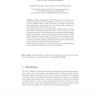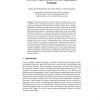1875 search results - page 318 / 375 » Modeling the Security of Steganographic Systems |
CSFW
2011
IEEE
12 years 9 months ago
2011
IEEE
—Randomization is used in computer security as a tool to introduce unpredictability into the software infrastructure. In this paper, we study the use of randomization to achieve ...
ESOP
2010
Springer
14 years 7 months ago
2010
Springer
Transient faults are single-shot hardware errors caused by high energy particles from space, manufacturing defects, overheating, and other sources. Such faults can be devastating f...
SAFECOMP
2007
Springer
14 years 4 months ago
2007
Springer
Abstract. Esterel Technologies’ SCADE Suite is one of the most important development tools for software for safety-critical systems. It is used for designing many critical compon...
POPL
1999
ACM
14 years 2 months ago
1999
ACM
Linking is a low-level task that is usually vaguely specified, if at all, by language definitions. However, the security of web browsers and other extensible systems depends cru...
RAID
2010
Springer
13 years 7 months ago
2010
Springer
Enterprise networks face a variety of threats including worms, viruses, and DDoS attacks. Development of effective defenses against these threats requires accurate inventories of n...


